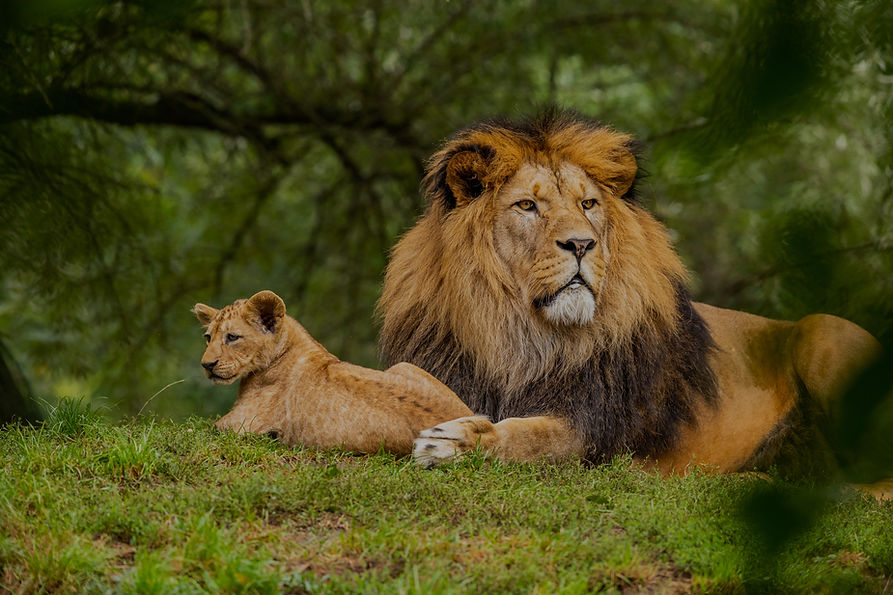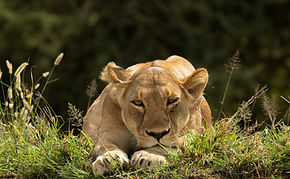
Experience the Big Five Safari in Tanzania
The Big Five in Tanzania
A Big Five Safari in Tanzania is more than just a wildlife tour—it’s a deep dive into the soul of Africa. Here, in the heart of the continent’s most iconic national parks, you’ll have the extraordinary opportunity to witness the legendary lion, elephant, leopard, buffalo, and rhinoceros roaming free in their natural habitat.
Unlike in many parts of Africa, Tanzania offers one of the highest chances to see all Big Five in a single journey. From the endless plains of the Serengeti, to the lush forests of Tarangire, and the breathtaking Ngorongoro Crater, each ecosystem plays host to these majestic species in different ways—offering a uniquely thrilling and balanced safari experience.
At Gnade Safaris, we specialize in crafting personalized Big Five journeys guided by expert naturalists who know exactly where and when to find each species. Whether you're a wildlife photographer capturing the elusive leopard at dawn or a family witnessing a lion pride resting under an acacia tree, every moment becomes a lifelong memory.
Historically known as the most dangerous animals to hunt on foot, the term "Big Five" has evolved from its colonial-era roots to symbolize the ultimate wildlife bucket-list. Today, these magnificent creatures are admired through lenses—not rifles—with conservation-minded travelers seeking to witness, protect, and celebrate Africa’s raw, untamed beauty.
Tanzania’s Big Five experience stands apart due to:
-
Abundant wildlife populations year-round
-
Diverse landscapes that support multiple ecosystems
-
Professional guides trained in conservation, photography, and ecology
-
Eco-lodges and mobile camps that let you sleep surrounded by nature
So whether you're a first-time visitor or a seasoned safari-goer, let Tanzania's Big Five introduce you to the thrill, elegance, and emotion of a truly wild Africa. With Gnade Safaris, you don’t just see the Big Five—you experience them, deeply and respectfully.
Our Top Packages For Big Five Experience
What Is the Big Five?
The Big Five refers to Africa’s five most iconic and revered wild animals—lion, elephant, rhino, leopard, and buffalo—originally named by big-game hunters for the challenge and danger of hunting them on foot. Today, these species are celebrated not as trophies but as the ultimate wildlife sightings for safari travelers. In Tanzania, visitors have a rare opportunity to see all five in some of the continent’s most protected and wildlife-rich environments.

1. The Majestic Lion
-
Scientific Name: panthera leo
-
Family: cats (Felidae)
-
Habitat Northern Circuit: Lake Manyara, Tarangire, Ngorongoro, Serengeti
-
Population in Tanzania: ca. 15.000 (2010)
-
Diet: antelope, gazelle, gnus, buffalo, zebras
-
Head-and-body length: 140 – 250 cm
-
Weight: 120 – 270 kg
-
Sexual Maturity: ca. 4 years
-
Life Span: ca. 15 years (zoo animals up to 25 years)
-
IUCN Status: vulnerable
The lion, known as the “King of the Jungle,” is an essential symbol of African wilderness. In Tanzania, you’ll often encounter prides lounging under acacia trees in the Serengeti or prowling through the Ngorongoro Crater. These apex predators hunt cooperatively, making their hunts a thrilling spectacle. Lions are especially photogenic at golden hour, making them a favorite for wildlife photographers on a Big Five safari.
2. The Mighty Elephant
-
Scientific Name: loxodonta africana
-
Family: elephants (Elephantidae)
-
Habitat Northern Circuit: Lake Manyara, Tarangire, Ngorongoro, Serengeti, Arusha
-
Population in Tanzania: ca. 43.000 (2014)
-
Diet: grasses, leaves, twigs
-
Head-and-body length: 250 – 750 cm
-
Weight: 3200 – 6500 kg
-
Sexual Maturity: ca. 12 – 15 years
-
Life Span: ca. 40 bis 80 years
-
IUCN Status: endangered
Tanzania’s elephants are some of the largest and most graceful mammals in Africa. With their immense size and calm demeanor, they inspire awe as they roam the savannahs of Tarangire, where they often gather in large herds around ancient baobab trees and riverbeds. Watching a mother elephant guide her young through the bush is one of the most touching moments on safari.

3. The Rare Rhino
-
Scientific Name: diceros bicornis
-
Family: rhinocerotidae
-
Habitat Northern Circuit: Ngorongoro, Serengeti
-
Population in Tanzania: less then 1000
-
Diet: leaves, branches, twigs, bark, thorns
-
Head-and-body length: 280 – 360 cm
-
Weight: 800 – 2500 kg
-
Sexual Maturity: ca. 4 – 6 years
-
Life Span: up to 45 years
-
IUCN Status: critically endangered
The black rhino, critically endangered and fiercely protected, is a rare but unforgettable sight in Tanzania. Your best chance to spot this prehistoric-looking creature is within the Ngorongoro Crater, one of the few places where they roam freely in a secure environment. With their hooked upper lips and horned profiles, rhinos symbolize resilience and conservation efforts across Africa.

4. The Elusive Leopard
-
Scientific Name: panthera pardus
-
Family: felidae
-
Habitat Northern Circuit: Serengeti, Ngorongoro, Tarangire
-
Population Tanzania: ca. 15.000 to 20.000
-
Diet: antelopes, wild boars, birds, zebras
-
Head-and-body length: 90 to 185 cm
-
Weight: 25 to 100 kg
-
Sexual Maturity: ca. 3 years
-
Life Span: ca. 12 to 18 years
-
IUCN Status: vulnerable
The leopard is the most secretive of the Big Five, often hidden in the high branches of trees or lurking in thick woodland. Seronera Valley in the Serengeti is one of the best places in Tanzania to spot these stealthy hunters. With their powerful build, dazzling coats, and nocturnal behavior, leopards offer some of the most magical and rewarding wildlife encounters—if you can find them.

5. The Powerful Buffalo
-
Scientific Name: syncerus caffer
-
Family: bovidae
-
Habitat Northern Circuit: Lake Manyara, Tarangire, Ngorongoro, Serengeti, Arusha
-
Population: 100.000+
-
Diet: grasses
-
Head-and-body length: 240 – 340 cm
-
Weight: 300 – 900 kg
-
Sexual Maturity: ca. 4 – 5 years
-
Life Span: ca. 18 to 25 years
-
IUCN Status: least concern
Don’t let the buffalo’s grazing posture fool you—they are strong, unpredictable, and fiercely defensive. Often found in large herds in both Tarangire and the Serengeti, African buffaloes are social animals that stick together to fend off predators. Their sharp horns and bold presence make them a thrilling addition to any Big Five checklist.


Why Choose a Big Five Safari in Tanzania?
🦓 Broadest Big Five Concentration
Tanzania offers some of Africa’s highest chances to spot all Big Five, especially in Serengeti National Park and the Ngorongoro Crater. These parks are teeming with lions, elephants, rhinos, leopards, and buffalo—often seen in a single game drive.
🧭 World-Class Safari Guides
Tanzanian safaris are led by expert local guides trained to track elusive animals and share deep insights into their behavior. Their knowledge turns each drive into an engaging and educational wildlife experience.
🛌 Luxury, Comfort & Variety
From mobile bush camps following the migration to 5-star lodges with infinity pools and spa treatments, Tanzania offers unmatched diversity. There’s something for every traveler—honeymooners, families, or adventure seekers.
🌱 Conservation-First Ethics
A Big Five safari in Tanzania supports community-based tourism and wildlife conservation. Operators like Gnade Safaris prioritize eco-friendly practices and park fees contribute to protecting endangered species and local ecosystems.
Best Locations to Spot the Big Five in Tanzania
🌄 Serengeti National Park
The Serengeti is a Big Five stronghold, especially known for its large lion prides, elusive leopards, and massive buffalo herds. Elephants roam freely, and while rare, rhino sightings do occur in specific areas. Visit during the Great Migration for predator-prey drama and thrilling encounters.
🌋 Ngorongoro Crater
This UNESCO World Heritage Site is one of the best places in Africa to see all Big Five in a single game drive. Its lush caldera landscape supports healthy black rhino populations, and close encounters with lions, elephants, and buffalo are common. A must-visit for time-conscious travelers.
🌳 Tarangire National Park
Renowned for its massive elephant herds and ancient baobab trees, Tarangire also boasts strong lion and buffalo populations. The park is quieter than Serengeti or Ngorongoro, offering a more intimate safari experience. It’s ideal for birdwatchers and off-the-beaten-path explorers.
☀️ Dry Season (June–October)
This is the peak season for Big Five safaris thanks to clear skies and sparse vegetation, making animals easier to spot. Water sources dry up, drawing wildlife closer together—perfect for high-density sightings and photography. Road conditions are also best during this time.
🐾 Migration Months (January–March & July–September)
Combine the Great Migration with Big Five encounters for a truly unforgettable safari. Early in the year, calving attracts predators in the southern Serengeti; mid-year, river crossings bring high drama and hunting action in the north. A dream for wildlife lovers and photographers.
🍃 Shoulder Seasons (November & April–May)
Enjoy lush landscapes, fewer crowds, and great value during these in-between periods. Wildlife viewing remains excellent, especially in Ngorongoro and Tarangire, which are less affected by seasonal movement. Ideal for travelers seeking serenity and lower safari costs.


Book Your Big Five Safari Today
Let Gnade Safaris create your personalized Big Five adventure—from premium camps to expert guides—for the ultimate wildlife experience.
📧 Email: info@gnadesafaris.com



